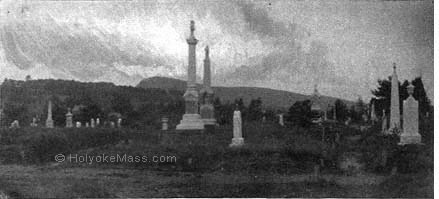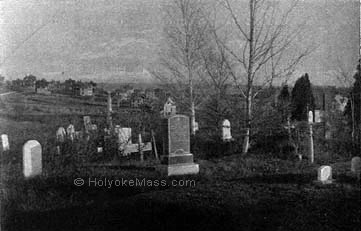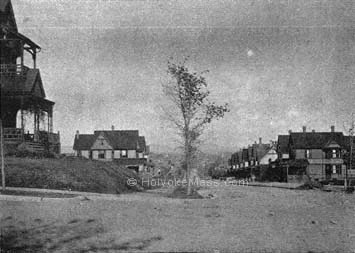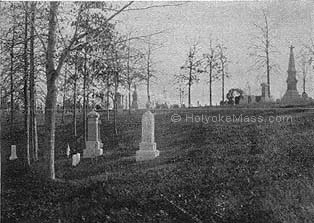
Sunset, St. Jerome’s Cemetery.
|
Just above the park are the steam sawmills and all about them on the hillside great piles of boards and slabs. The river thereabouts is crowded with the logs floated down from the head waters of the stream, and booms and spiles are everywhere. It is a busy place, and the work and workmen are quite interesting. There is a fascination about the water always, and the ability these men show in jumping about on the floating logs seems an accomplishment worth aspiring to. Between the millyard and the humbler homes of the vicinity, you can see at almost any hour an odd set of pilgrims going to and fro, some of them old men or old women who come away bent beneath the great bundles of refuse wood on their backs, and some of them small boys with little carts with which they bring away loads of like character. Among these boys are certain fortunate ones, who own goats which they harness into the carts and make do the drawing.
The neighborhood below the millyard is commonly known as "The Patch." It is a mixed-up region of narrow streets and alleys and wooden tenements, not over clean and not over agreeable in its odors. In fact, it seems to the observer that not a few of the buildings could be spared with advantage to the city, and health and comfort of the residents. Noticeable in this region is the number of child cripples who are about the sidewalks.

Looking Toward the City from St. Jerome’s Cemetery.
|
But follow any of the streets to the south and the surroundings at once become more cheerful. There are trees shadowing the walks, lawns before the houses, and everything trim and neat. The homes, both the cottages and the more commodious dwellings, look comfortable and attractive. This region of pleasant, separate homes, extends in a wide sweep far back up the hill to Northampton street. The cottage house is the most common, but there are many handsome mansions that in size and beauty of architecture are worthy special admiration. The lay of the land is peculiarly well adapted to the attractive placing of fine buildings. It rises gently, with here and there a slightly bolder ridge, and everywhere is chance for a wide outlook over the whole valley. The district is fast filling up, but there are still in places open fields where a few pines and chestnuts and clumps of birches grow — relics of the old time-pastures. From among them can be had very pretty glimpses of the fine houses of the vicinity, in odd yet attractive contrast with their surroundings.
Nearby is Forestdale cemetery. It is pleasantly avenued with tree-lined roadways, and is agreeably broken with little valleys and low hills. A tiny lake sleeps in one hollow, and there are fountains on the higher ground, and ornamental shrubs and flowering plants are everywhere. Higher on the hill, only separated from Forestdale by a narrow street is the cemetery of the Roman Catholics. It has a fine situation, with wide views about, and a particularly good outlook toward Mt. Tom. If the grounds are well cared for, time will enhance the size and beauty of the tree growths and make the place especially attractive.
To the north of the cemetery are the "Highlands," a level plateau of considerable extent, which is one of the most attractive residence portions of the city. Northampton street may be considered the western boundary of the city at present. It makes a long line north and south, at the base of a high ridge rising beyond, where are pastures and patches of woodland. This ridge is most attractive tramping ground. The views north and east are deligntful. Where it dips toward the northern valley, you look across a long stretch of farming country, to the blue ranges of the mountains at the far horizon, and nestling among them catch a single glimpse of a gleaming bit of the Connecticut — a pearl soft-shining in the surrounding green. The view east overlooks the whole city and the plains beyond the river, mellowing away into the distance. I explored this ridge one autumn day. It was very pleasant with its corn stacks and pumpkins in the ploughed fields, and its rough pastures and stone fences and far views. There were groups of cows feeding about or lying in the shadow of the trees, in interesting contrast with the wide spreading city so close below. Several goups of fine chestnut trees grow here. They are labeled with signs "No Trespassing," and though I saw a chestnut or two lying on the ground, I thought it best to withstand the temptation to pick them up.

Oak Street, From Essex.
|

In Forestdale Cemetery.
|
© Laurel O’Donnell 1996 - 2006, all rights reserved
This document may be downloaded for personal non-commercial use only
and may not be reproduced or distributed without permission in any format.
This is an edited adaptation from the original publication.
|